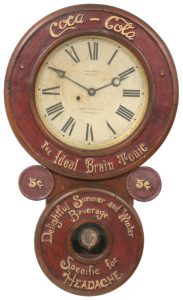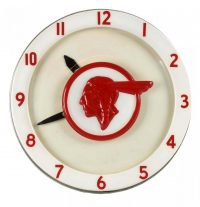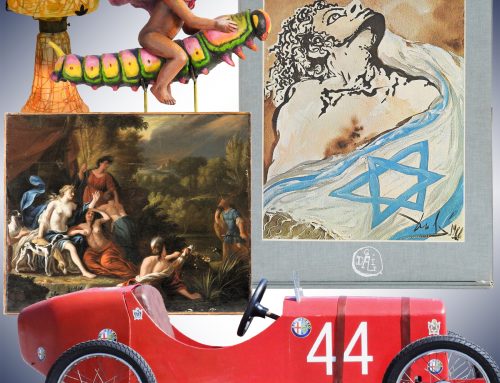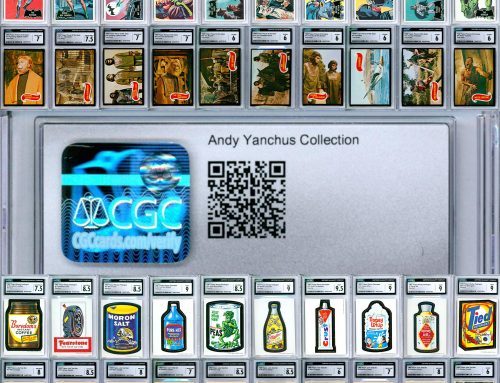Advertising Clocks
 A clock, one of the most important tools used every day in every person’s life. The first mechanical clock using a verge escapement movement was invented during Medieval times in the 14th century. It was later replaced by the pendulum clock in 1656, a popular movement which is still commonly manufactured today. I’m the farthest thing from being a horologist, but there is your quick snippet history on the beginning of clocks. While I love and appreciate antique timepieces, this article relates to a different side of clock collecting.
A clock, one of the most important tools used every day in every person’s life. The first mechanical clock using a verge escapement movement was invented during Medieval times in the 14th century. It was later replaced by the pendulum clock in 1656, a popular movement which is still commonly manufactured today. I’m the farthest thing from being a horologist, but there is your quick snippet history on the beginning of clocks. While I love and appreciate antique timepieces, this article relates to a different side of clock collecting.
Every antique dealer will tell you that American banjo clocks, shelf clocks, grandfather clocks or French gilt bronze mantel clocks have been dying at auction. Every year on average they depreciate in the marketplace, unless you have such a truly exceptional and rare example that the remaining hard-core clock aficionado’s will still support a high price. It is kind of like the 1986 film Highlander in that there can only be one. But generally speaking, as a rule of thumb 99% of clocks are worth 1/10th of what they used to be. However, while it may be an entirely different breed of collector, advertising clocks have never been hotter.
What’s an advertising clock? Well it’s right in the name in that it is a clock which also serves as a piece of advertising for a company or service. Advertising clocks have been a common practice since the late 19th century, for example the first Coca-Cola clock was introduced in the 1890’s. Manufactured by Baird Clock Co. with a Seth Thomas movement, the average example brings $6,000-$8,000 with an exceptional example having sold for $15,000 in 2018. Compared to the average 1890’s 8-Day wall clock which barely sells for $100 I’d say it makes a big deal having that Coca-Cola branding. Now the Baird clock is a very early example, and one which I’d say is obscure to own for the average advertising clock collector. The sweet spot era for clocks of this type is certainly in the 1940’s to 1960’s.
 Porcelain, neon, unbelievable graphics, are all part of the equation as to what makes an advertising clock desirable. At the top of the food chain is automotive and Coca-Cola related clocks. It is what it is in that people love their cars, and if you were driving around in a 1957 Bel Air in high school odds are you were also drinking Coca-Cola from the local sundry. Now while the Baird clock for $15,000 was impressive the right Coca-Cola neon can bring $30,000 plus. A large-scale building side clock once sold for $50,000! That’s a lot of money for a clock, but outside of the extreme scenarios your average neon advertising clock for Coca-Cola, Chevrolet, Cadillac, or Ford range between $3,000-$5,000. That is a very broad appraisal but it is for the purpose of this article. The point is that neon + porcelain + Pontiac does not equal a $300 to $500 dollar clock.
Porcelain, neon, unbelievable graphics, are all part of the equation as to what makes an advertising clock desirable. At the top of the food chain is automotive and Coca-Cola related clocks. It is what it is in that people love their cars, and if you were driving around in a 1957 Bel Air in high school odds are you were also drinking Coca-Cola from the local sundry. Now while the Baird clock for $15,000 was impressive the right Coca-Cola neon can bring $30,000 plus. A large-scale building side clock once sold for $50,000! That’s a lot of money for a clock, but outside of the extreme scenarios your average neon advertising clock for Coca-Cola, Chevrolet, Cadillac, or Ford range between $3,000-$5,000. That is a very broad appraisal but it is for the purpose of this article. The point is that neon + porcelain + Pontiac does not equal a $300 to $500 dollar clock.
If you want to collect these bad boys you need to bust out the check book. Advertising clocks also carry the lore in that they were not mass produced, they were intended to be hung on store fronts, dealerships, or service centers. So, the next time you’re driving through an old neighborhood make sure to look up and you may be knocking on someone’s door.



